By Guest Blogger Kelly Gunzenhauser
You may ask, why write about a trip to Williamsburg in the wintertime? My boys are ages 9 and 12, and it is getting to that point we all reach, especially with boys, where toys are starting to fall by the wayside. I don’t like to overdo it with expensive electronics at Christmastime, so I have started giving experiences instead of piles of presents. This year, we decided to go to Williamsburg the day after Christmas. There is so much to do and see there, and we learned a few tricks on our first trip with the kids.
As we planned our trip, we acknowledged that the weather was going to really play a part in how much we could do. December in Virginia is just like December in North Carolina—you never know what you’re going to get. So we did two things for “insurance” for our good time. First, we made sure we stayed in a place with a fairly large, heated, indoor pool, and a hot tub for the adults. Second, we purchased what are called “bounce 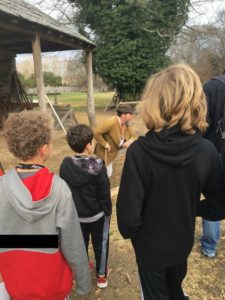 passes” or “bounce tickets.” Each person wears his ticket on a lanyard and the tickets entitle you to unlimited visits to Williamsburg (and to Busch Gardens, if you like) for the number of days you stay there. So if it rained or was freezing, we could spend a little time at either park, then go swim in the hotel pool, then come back when the weather got better. Even though we got lucky with the weather, the bounce ticket was a brilliant choice, and I think it would work well for the hot summer as well as the winter. It takes away that feeling that you have to slog though an entire attraction no matter what.
passes” or “bounce tickets.” Each person wears his ticket on a lanyard and the tickets entitle you to unlimited visits to Williamsburg (and to Busch Gardens, if you like) for the number of days you stay there. So if it rained or was freezing, we could spend a little time at either park, then go swim in the hotel pool, then come back when the weather got better. Even though we got lucky with the weather, the bounce ticket was a brilliant choice, and I think it would work well for the hot summer as well as the winter. It takes away that feeling that you have to slog though an entire attraction no matter what.
A quick word about Busch Gardens—it deserves its own blog, but for the record, many of the rides were closed for the winter. Instead of rides, they offered shows, and also Christmas Town—theydecorated the entire park with thousands of lights. It was beautiful. It was also packed with people, so just be aware that unless the weather is bad, people still love Busch Gardens!
Now, on to Williamsburg. The first thing we learned that it’s a great idea to park at the Visitor Center and walk to the town, instead of trying to park closer or even instead of taking the shuttle. It’s a pretty walk, not crowded, and you have this really cool experience walking across the bridge to go “back in time.” There are plaques in the bridge that tell you how things change as you go back to the 18th century, and also as you leave the park and come back to the 21st century. My boys loved reading about how much things have changed. (When we tried to catch the shuttle at dusk, it was too cr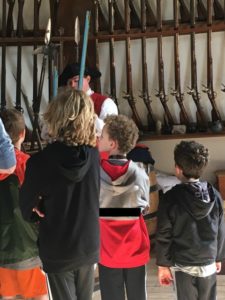 owded for us to get on and we ended up walking back anyway, but I am sure people have better luck with the Express Shuttle. We rode it in from the Visitor Center one day and it was convenient and easy.)
owded for us to get on and we ended up walking back anyway, but I am sure people have better luck with the Express Shuttle. We rode it in from the Visitor Center one day and it was convenient and easy.)
On the outskirts of the park when walking from the Visitor Center, you get to see the grounds of a plantation, including a slave dwelling. Williamsburg is actively growing and changing; it is not a stagnant place. Near the plantation, there were two men splitting wood to make clapboards for a new building (a historic reproduction) that is planned in the downtown portion of Colonial Williamsburg. So, some of the work you see is real. This goes a long way toward transporting you back in time, because the “colonists” aren’t just repeating tasks over and over for show. They have real projects and jobs to complete, and can walk you through what they are doing over time.
As you get into the larger part of the town there are many more buildings that welcome visitors. Some of the places will scan your ticket; others do not. We enjoyed the armory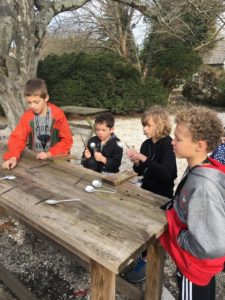 , the blacksmith, the talk about rare breeds of animals, the wigmaker, the courthouse (I may have a budding lawyer on my hands), the gaol (jail), the tinsmith, and the maze behind the Governor’s Palace, as well as a talk by the Governor’s personal chefs. And of course, everyone has their photo taken in the stockades.
, the blacksmith, the talk about rare breeds of animals, the wigmaker, the courthouse (I may have a budding lawyer on my hands), the gaol (jail), the tinsmith, and the maze behind the Governor’s Palace, as well as a talk by the Governor’s personal chefs. And of course, everyone has their photo taken in the stockades.
While my kids had their favorite areas, all places were interesting. The costumed staff are amazingly knowledgeable about Williamsburg in general and especially the places where they work. I found out at one point that the whole exhibit runs on a reduced schedule in January so that all of the “colonists” can receive more training.
The “colonists” can give you a detailed history lesson and were quite adept at fielding both questions from children (who will ask just about any crazy question they can think of) and from people who obviously styled themselves as “experts” in certain historic areas. For example, in the blacksmithing workshop, a woman was in the background working on making tiny nails for horseshoes. A tourist commented that it would likely be unusual to see a woman working in this shop in the real 18th century. The man giving the talk responded by saying that in the colonies, everyone had to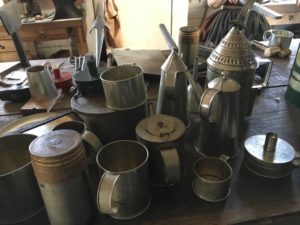 work hard in order for the community to survive. They needed all hands to do all things, and so sometimes women did work in trades as well as in the home. The nails she was making will be used to shoe the horses that pull the many carriage rides taken through the town.
work hard in order for the community to survive. They needed all hands to do all things, and so sometimes women did work in trades as well as in the home. The nails she was making will be used to shoe the horses that pull the many carriage rides taken through the town.
One of the real treats of our visit was dining. We learned a secret: if you want to eat lunch at one of the historic taverns, plan to eat early. At 11:30, all of the taverns open and they will usually seat you fairly quickly, whereas lines are much longer within a half hour. The tavern food is mostly inspired by real colonial recipes. I assume some changes have been made to reflect more current tastes, but either way, it’s yummy. They have children’s fare, too, and they brew excellent root beer, which my boys were most happy to indulge in as part of their trip back in time. I had some meat pasties for one meal and peanut soup and pot pie for another, accompanied by hard apple cider. (One thing that was fun for us adults to get used to for a day was the prevalence of alcohol at lunchtime!)
Part of the charm of eating in the tavern is the wandering colonists who come into the taverns and talk to guests about life in Williamsburg. Some of them explain appropriate colony manners (bowing and curtseying—no handshakes!) while others might read decrees from the king or introduce you to popular music at the time. These on-the-spot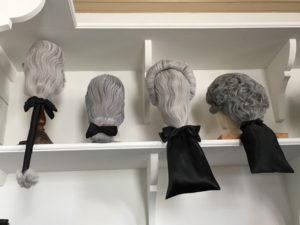 reenactments happen throughout the day in many different places, and often correspond to what was happening on particular days in history. If you visit on a day during which they are reenacting July 4th, you may hear the Declaration of Independence read aloud in the square, or see the king’s soldiers marching down the street.
reenactments happen throughout the day in many different places, and often correspond to what was happening on particular days in history. If you visit on a day during which they are reenacting July 4th, you may hear the Declaration of Independence read aloud in the square, or see the king’s soldiers marching down the street.
Be prepared to do a bit of shopping at Williamsburg. There are several gift shops in the Visitor Center, as well as on the main street of the park. There is also an open-air market. If you really want to immerse your children—and your wallet—in the 18th century, you can purchase costumes for the children in several of the shops. Bonnets and tricorner hats are available for purchase separately, as well. Colonial toys, toy guns, and books full of colonial recipes are also popular souvenirs. But probably, the most common thing people buy is balls of soap. We bought several to keep and to share with friends.
We feel like even with touring the better part of two days, there was so much more to see. We didn’t get to take any guided tours. There are several, including a ghost tour and a behind-the-scenes tour. We m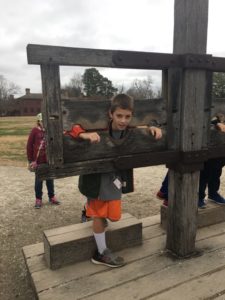 issed out on the local museums, and even missed going inside the governor’s palace—time just ran too short. And, I wish we had enough time to tour The College of William and Mary, whose campus backs up to Williamsburg, or the downtown area of Williamsburg that is not historic, but still looks like a lot of fun. We also missed out on some of the historic sites, like the wheelwright, the apothecary, and the saddle maker.
issed out on the local museums, and even missed going inside the governor’s palace—time just ran too short. And, I wish we had enough time to tour The College of William and Mary, whose campus backs up to Williamsburg, or the downtown area of Williamsburg that is not historic, but still looks like a lot of fun. We also missed out on some of the historic sites, like the wheelwright, the apothecary, and the saddle maker.
Overall, this was an extremely successful trip for my kids, both of whom have a historic bent anyway. They have already asked to go back, so hopefully we can plan a long weekend over the summer. If you visit during the summer, be prepared: Williamsburg can suffer sweltering heat and humidity! But we also will have time to visit Yorktown and Jamestown (two other historic sites), maybe the beach, Busch Gardens with all of the rides, and if my kids get their way, the nearby Ripley’s Believe it or Not. Maybe, if we get really lucky, we will get to stay on site and wake up each day in the 18th century.
Helpful Links on the Williamsburg.com site (which is overwhelming):
- This link helps you figure out what’s going on as far as tours and talks. It’s especially useful since it tells you where certain reenacters are going to be at different times. http://mediaserver.history.org/ThisWeek/week.pdf
- Guide to people of Colonial Williamsburg: http://www.history.org/almanack/people/people.cfm?sort=new
- Guide to all of the additional museums: http://www.history.org/history/museums/index.cfm

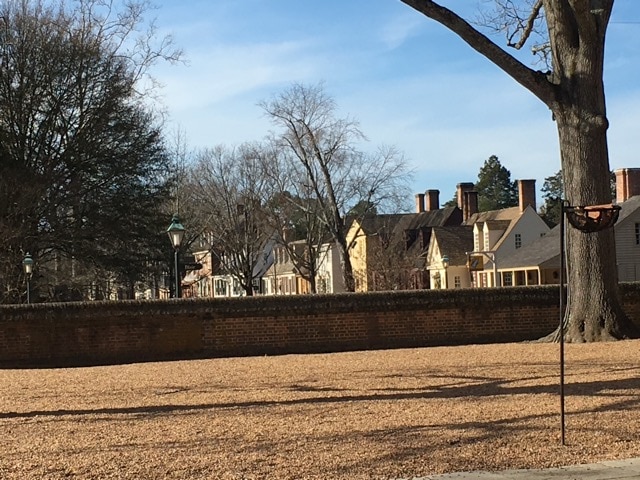















We spent a day in Williamsburg over spring break last year and also a few hours at Jamestown the next day before heading home. Great tips! We were particularly interested to watch the glassblower in Jamestown and compare it to the glass artists we have seen locally at The Olio.